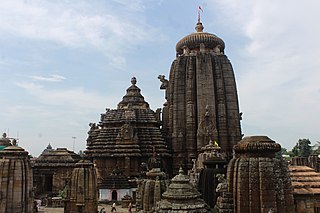Lingaraja temple
The Lingaraja Temple in the east Indian city of Bhubaneswar in the state of Odisha is one of the most important Hindu temples in the country. The temple is still used for cult purposes and is closed to tourists; However, views and photos from a platform outside the surrounding wall of the temple precinct are permitted.
Consecration
The term Lingaraja (German: 'King / Lord of the Lingam') clearly means Shiva , but local tradition points to a Harihara temple, which is dedicated to Shiva and Vishnu in their common form as Harihara . In the cella ( garbhagriha ) of the temple there is a lingam over 2 m high , but there are also several Vishnu statues in a prominent place inside the temple. With the Jagannath Temple consecrated to Vishnu in Puri , 30 km to the south, the Vishnu cult had achieved great importance in the region, which could not be ignored even in the largest shrine in Bhubaneswar. So it was decided to include Vishnu in the worship, which was most easily possible in the form of Harihara .
history
According to tradition, the origins of the Lingaraja Temple can be traced back to the 7th / 8th centuries. It can be traced back to the 14th century, but the four components of today's temple date from the 11th and early 12th centuries. Other smaller temples were added over time, so that sometimes it is referred to as a Panchayatana floor plan, which, however, is only partially recognizable due to the large number of buildings on the site.
architecture
The most striking component of the temple, which is oriented in east-west direction, is the almost 45 m high tower ( rekha-deul ), which surrounds and elevates the cella ( garbhagriha ) in the west ; In front of it there is a meeting hall ( jagamohana ) with a stepped pyramid roof ( pitha-deul ) - both components are commonly dated to the 11th century, whereas the two-part entrance area consisting of a so-called dance hall ( natamandira ) and a sacrificial hall ( bhogamandapa ) dates from the early 12th century . Century is assigned. All components have slightly different heights, so that the path of the believers to the significantly higher cella, which can only be entered by Brahmins , is like the ups and downs of a mountain path ; the association of a north Indian temple (especially a large temple) with an abstract mountain range ( Himalaya ) has been formulated repeatedly in the literature.
The tower, which appears almost octagonal on the outside, encloses a square cella on the inside; it closes at the top with an almost floating Amalaka ring stone, the tip of which is formed by an auspicious jug ( kalasha ). Both motifs are repeated in a slightly different form on the three other roofs of the temple.
meaning
The Lingaraja Temple is often compared to the large temples in the temple district of Khajuraho ( Lakshmana Temple , Vishvanata Temple and Kandariya Mahadeva Temple ) that were built between around 930 and 1050 . In contrast to this, the Lingaraja Temple does not stand on a high platform ( jagati ), but on a base zone about one meter high in slightly submerged flat terrain, which means that the previously so important ritual circumnavigation ( pradakshina ) during the monsoon season or was not possible in heavy rain. In addition, due to the lack of balconies ( jarokas ), the building looks rather hermetically sealed and significantly more forbidding than the temples of Khajuraho. In addition, the (erotic) sculptural jewelry that is so striking for Khajuraho is missing at the Lingaraja Temple.
Others
The Lingaraja Temple has received a multitude of endowments in the form of money and land throughout its long history. There are also graduated fees for the priests' ceremonies. In 2011, this raised more than 5 million rupees - a considerable sum by Indian standards.
literature
- Debala Mitra: Bhubaneswar. Archaeological Survey of India , New Delhi 1984
- Andreas Volwahsen, Henri Stierlin (Ed.): India. Buildings of the Hindus, Buddhists and Jains. Taschen-Verlag, Cologne undated, ISBN 3-8228-9532-6 .
- Robert Strasser: Orissa, Bihar, West Bengal. Indoculture, Stuttgart 1991, ISBN 3-921948-10-X , p. 74 ff
Web links
Individual evidence
- ↑ z. B. by George Michell: The Hindu Temple. Architecture of a world religion. DuMont, Cologne 1991, p. 86, ISBN 3-7701-2770-6 .
Coordinates: 20 ° 14 ′ 19 ″ N , 85 ° 50 ′ 1 ″ E

